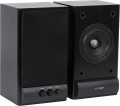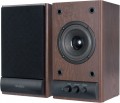Frequency range
The range of audio frequencies supported by acoustics. The wider this range — the fuller the reproduced sound, the lower the likelihood that some of these details at low or high frequencies will remain “behind the scenes”. At the same time, the human ear is able to hear frequencies of the order of 16 – 22,000 Hz, and with age, this range narrows even more. In modern audio equipment, especially at the top level, there may be more extensive ranges, but from a practical point of view, this does not make much sense. In addition, it is worth noting that a wide frequency range in itself does not guarantee high-quality sound — a lot also depends on the frequency response.
Impedance
The electrical resistance of the speakers to alternating current. This parameter is important primarily for normal compatibility with the amplifier: too low speaker impedance can lead to distortion, overload, and even damage to the speakers, and too high impedance can reduce the sound volume. At the same time, the vast majority of modern computer acoustics have their own amplifiers and are connected via a line input. Therefore, the impedance data is more of a reference value; in fact, this indicator may be needed only when connecting speakers to a “non-native” power amplifier, bypassing the standard one.
Functions
—
Bluetooth. A technology used to wirelessly connect various devices. Allows you to transmit an audio signal, for this purpose it is most often used in computer speakers. This feature is especially convenient when using speakers with equipment that has its own Bluetooth modules — primarily with laptops and monoblocks; it is also possible to connect to compact gadgets like a smartphone or tablet (although it is usually more convenient to use specialized self-powered speakers with such devices). And for computers that do not have Bluetooth, separately connected adapters are available. The range of such a connection is at least several metres; the convenience of the lack of extra wires is obvious. However note that a regular Bluetooth connection compresses the sound quite strongly and may degrade its quality. Therefore, if this moment is critical for you, you should choose speakers with support for one of the aptX options or with a higher Bluetooth version. Each next "generation" has additional features.
—
Support for aptX. A feature found in Bluetooth speakers (see above). The aptX codec is used to improve the quality of audio transmitted over such a connection; according to the creators, it allows you to achieve quality comparable to Audio CD (16-bit/44.1kHz). Thus, if a regular Bluetooth connection can significantly degrade the sound of even MP3 files with a decent bitrate (not to mention lossless
...formats), then when using this codec, the sound quality is often limited not by the properties of the channel, but by the properties of the source file and the acoustics itself . Of course, for aptX to work, it must be supported not only by the speakers, but also by the signal source.
— Support for aptX HD. Support for the aptX HD codec, an updated version of the original aptX (see above). This standard achieves sound clarity comparable to Hi-Res (24-bit/48kHz) audio. On the other hand, its support is more expensive; and the differences from the original aptX only become noticeable on very high-quality audio materials, for which computer speakers are rarely used. Therefore, this function has not received much distribution.
— NFC. Technically, NFC is a universal wireless technology with a range of up to 10 cm, which allows to achieve a very wide range of applications. However, in computer speakers, this technology is mainly used to speed up Bluetooth connection (see above): it is enough to bring another NFC device (for example, a smartphone) to the speaker chip — and the chips will “recognize” each other and automatically set up the connection, the user will only have to confirm his.
— USB A. USB port, which allows you to connect external peripheral devices to the speakers — primarily drives like "flash drives". Most often, such a connection is used to play music from external drives — in other words, the presence of USB A turns the speakers into a standalone music centre. Often, it is also possible to charge portable gadgets (for example, smartphones) from this port. On the other hand, note that speakers with this feature are noticeably more expensive than similar models without USB, and they may be inferior in sound quality due to the presence of additional electronics that can interfere.
— Card Reader. Own device for reading memory cards, most often the SD standard. Speakers with a card reader can work like a stand-alone music centre: music from a memory card can be played even without a computer. At the same time, the card reader itself is used only by speakers; the ability to read a memory card by a computer is usually not provided in such models. It is also worth bearing in mind that the memory card slot and the electronics that “serve” it are a potential source of interference, so speakers with this function may be inferior in sound quality to counterparts without a card reader (at a higher cost).
— FM receiver. The presence of a built-in FM tuner allows you to use the speaker system as a radio receiver — to receive and play FM radio broadcasts. It should be noted that for reliable reception, most likely, an external antenna will be required; a cable for connecting it is sometimes included, but the antenna itself must be purchased separately.
— Treble adjustment. The ability to separately change the volume of high frequencies. In fact, it is the most simplified version of the equalizer: it allows you to adjust the overall colour of the sound by changing the HF level relative to the rest of the frequency spectrum. Most often used in combination with bass control (see below), but can also be provided as the only frequency control.
— Bass adjustment. The ability to separately change the volume of high frequencies. Similar to the treble control described above, used to adjust the overall tone of the sound. At the same time, quite a few models with this function have only a LF control (without a HF control). But do not confuse this function with subwoofer level control. In this case, it is precisely the adjustment of the lower frequencies of the entire system that is implied.
